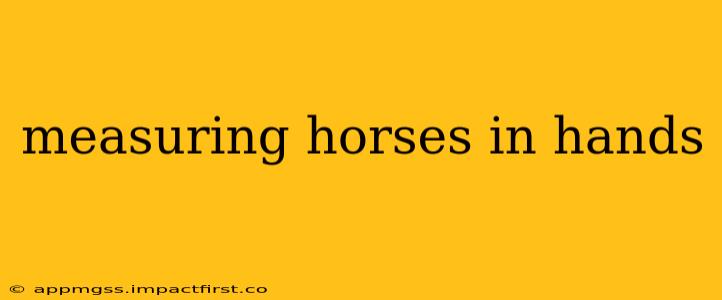For centuries, horse enthusiasts have used a unique unit of measurement: the hand. Understanding how to measure a horse in hands, and what this measurement signifies, is crucial for anyone involved in the equine world, from breeders and owners to veterinarians and farriers. This guide will delve into the intricacies of hand measurements, clearing up any confusion and providing a comprehensive understanding of this age-old practice.
What is a Hand?
A hand, in the context of horse measurement, is precisely 4 inches. It's a surprisingly simple unit, but its historical significance and continued use within the equestrian community highlight its enduring practicality. The measurement is taken from the highest point of the horse's withers (the ridge between the shoulder blades) to the ground. This point is consistently used because it represents a relatively stable anatomical landmark, less prone to variation than other body parts.
How to Measure a Horse in Hands
Measuring a horse accurately requires a few tools and a steady hand (pun intended!). You'll need:
- A measuring stick or tape measure: Ideally, one specifically designed for measuring horses, often featuring hand markings. These are readily available at most equestrian supply stores.
- A level surface: Ensure the horse is standing squarely on a level surface, such as a concrete floor or a well-packed dirt area. Uneven ground will lead to inaccurate readings.
- Patience and assistance: It's often easier to have a helper to hold the horse still while you take the measurement.
The process is straightforward:
- Position the measuring stick: Place the base of the measuring stick or tape measure against the highest point of the horse's withers.
- Read the measurement: Note the measurement where the stick or tape touches the ground. The reading will be in hands and inches, often expressed as "hands high." For example, a horse measuring 15 hands and 2 inches is written as 15.2 hh.
Remember to always measure the horse from the highest point of the withers for consistent and accurate results.
Why Measure Horses in Hands?
The use of hands persists for several reasons:
- Historical tradition: The system has been in use for centuries, making it a deeply ingrained part of equestrian culture.
- Simplicity and ease of understanding: The system is relatively easy to understand and use, even for those unfamiliar with the metric system.
- Breed standards: Many horse breeds use hand height as a key factor in determining breed standards and conformation.
What Does the Hand Height Indicate?
A horse's hand height is an important indicator of its size and often correlates with other physical attributes. While not a perfect predictor, it can provide a rough estimate of the horse's weight, strength, and suitability for certain riding disciplines. For example, taller horses often excel in disciplines requiring speed and power, while shorter horses might be better suited to specific riding styles.
What are the common heights of horses?
Horses come in a wide range of sizes. Ponies are generally under 14.2 hands high, while larger breeds can reach 17 hands or more. The specific height classifications often vary based on the breed or equestrian discipline, and there are several sub-categories between the extremes, with some having specific height restrictions for competition.
How do I convert hands to inches or centimeters?
Converting hands to inches is straightforward: simply multiply the number of hands by four. For example, a 16-hand horse is 64 inches (16 hands x 4 inches/hand). To convert inches to centimeters, multiply the inch measurement by 2.54. Conversely, to convert centimeters to inches, divide by 2.54 and then divide by four to find hands.
Why aren't all horses measured in metric?
While the metric system is widely used globally, the traditional use of hands for measuring horses persists. This is primarily due to historical reasons and the strong tradition within the equestrian community. Despite the prevalence of metric measurements in other areas, the hand measurement continues to be the standard in the equestrian world.
This comprehensive guide should equip you with the knowledge to accurately measure a horse in hands and understand the implications of this unique measurement. Remember, accurate measurement is crucial for various aspects of horse care and management.
